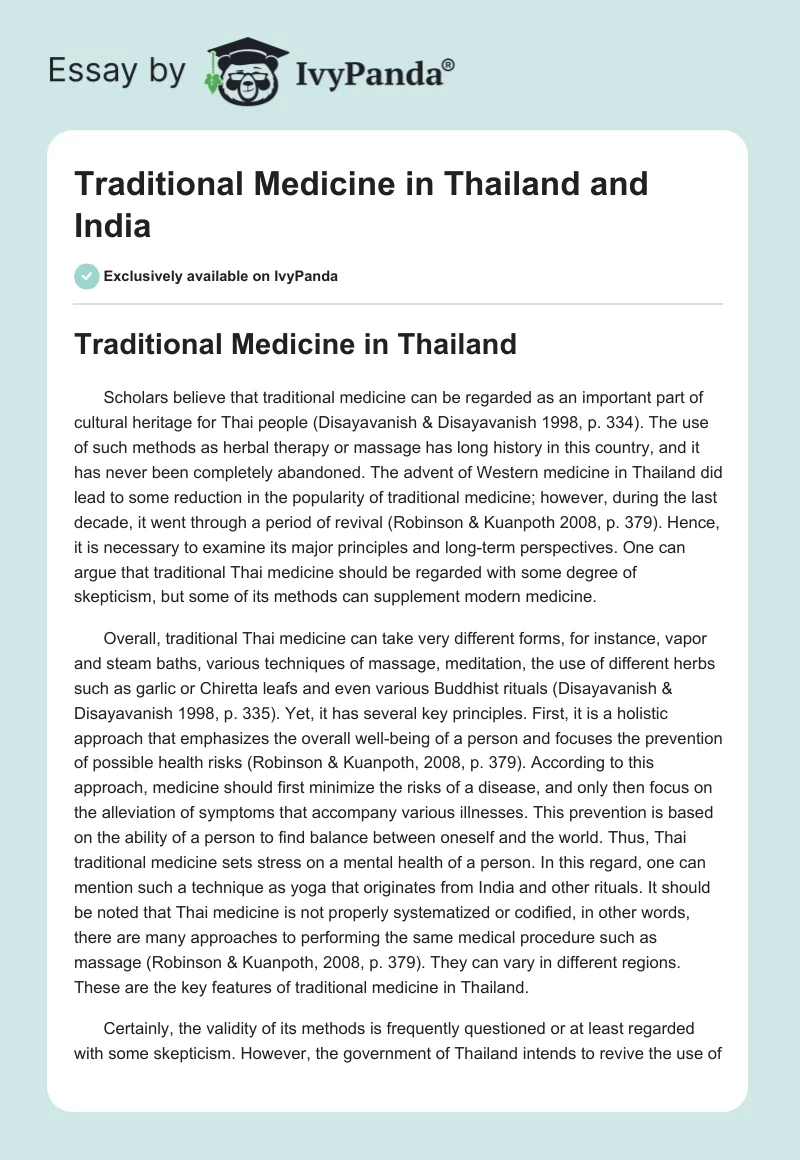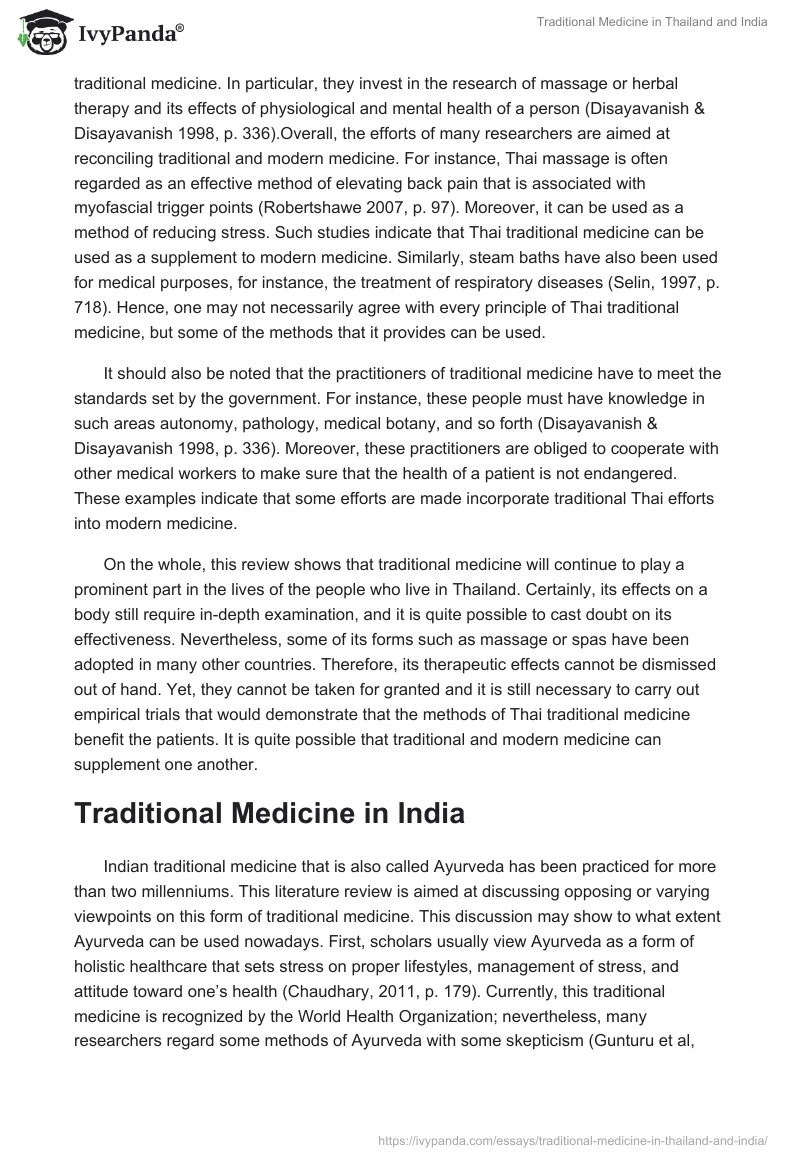Traditional Medicine in Thailand
Scholars believe that traditional medicine can be regarded as an important part of cultural heritage for Thai people (Disayavanish & Disayavanish 1998, p. 334). The use of such methods as herbal therapy or massage has long history in this country, and it has never been completely abandoned. The advent of Western medicine in Thailand did lead to some reduction in the popularity of traditional medicine; however, during the last decade, it went through a period of revival (Robinson & Kuanpoth 2008, p. 379). Hence, it is necessary to examine its major principles and long-term perspectives. One can argue that traditional Thai medicine should be regarded with some degree of skepticism, but some of its methods can supplement modern medicine.
Overall, traditional Thai medicine can take very different forms, for instance, vapor and steam baths, various techniques of massage, meditation, the use of different herbs such as garlic or Chiretta leafs and even various Buddhist rituals (Disayavanish & Disayavanish 1998, p. 335). Yet, it has several key principles. First, it is a holistic approach that emphasizes the overall well-being of a person and focuses the prevention of possible health risks (Robinson & Kuanpoth, 2008, p. 379). According to this approach, medicine should first minimize the risks of a disease, and only then focus on the alleviation of symptoms that accompany various illnesses. This prevention is based on the ability of a person to find balance between oneself and the world. Thus, Thai traditional medicine sets stress on a mental health of a person. In this regard, one can mention such a technique as yoga that originates from India and other rituals. It should be noted that Thai medicine is not properly systematized or codified, in other words, there are many approaches to performing the same medical procedure such as massage (Robinson & Kuanpoth, 2008, p. 379). They can vary in different regions. These are the key features of traditional medicine in Thailand.
Certainly, the validity of its methods is frequently questioned or at least regarded with some skepticism. However, the government of Thailand intends to revive the use of traditional medicine. In particular, they invest in the research of massage or herbal therapy and its effects of physiological and mental health of a person (Disayavanish & Disayavanish 1998, p. 336).Overall, the efforts of many researchers are aimed at reconciling traditional and modern medicine. For instance, Thai massage is often regarded as an effective method of elevating back pain that is associated with myofascial trigger points (Robertshawe 2007, p. 97). Moreover, it can be used as a method of reducing stress. Such studies indicate that Thai traditional medicine can be used as a supplement to modern medicine. Similarly, steam baths have also been used for medical purposes, for instance, the treatment of respiratory diseases (Selin, 1997, p. 718). Hence, one may not necessarily agree with every principle of Thai traditional medicine, but some of the methods that it provides can be used.
It should also be noted that the practitioners of traditional medicine have to meet the standards set by the government. For instance, these people must have knowledge in such areas autonomy, pathology, medical botany, and so forth (Disayavanish & Disayavanish 1998, p. 336). Moreover, these practitioners are obliged to cooperate with other medical workers to make sure that the health of a patient is not endangered. These examples indicate that some efforts are made incorporate traditional Thai efforts into modern medicine.
On the whole, this review shows that traditional medicine will continue to play a prominent part in the lives of the people who live in Thailand. Certainly, its effects on a body still require in-depth examination, and it is quite possible to cast doubt on its effectiveness. Nevertheless, some of its forms such as massage or spas have been adopted in many other countries. Therefore, its therapeutic effects cannot be dismissed out of hand. Yet, they cannot be taken for granted and it is still necessary to carry out empirical trials that would demonstrate that the methods of Thai traditional medicine benefit the patients. It is quite possible that traditional and modern medicine can supplement one another.
Traditional Medicine in India
Indian traditional medicine that is also called Ayurveda has been practiced for more than two millenniums. This literature review is aimed at discussing opposing or varying viewpoints on this form of traditional medicine. This discussion may show to what extent Ayurveda can be used nowadays. First, scholars usually view Ayurveda as a form of holistic healthcare that sets stress on proper lifestyles, management of stress, and attitude toward one’s health (Chaudhary, 2011, p. 179). Currently, this traditional medicine is recognized by the World Health Organization; nevertheless, many researchers regard some methods of Ayurveda with some skepticism (Gunturu et al, 2011). Thus, it is important to know about potential benefits and drawbacks of this therapy and the possibility of its use of the needs of the patients.
Overall, this form of traditional medicine encompasses a variety of techniques and methods, for example, yoga, various forms of herbal medicine, dieting, massage, baths, and so forth. These methods are based on certain philosophical principles according to which mental health is the key to preventing other diseases. Modern researchers have very conflicting viewed of Ayurvedic medicine. First, there is some evidence that this approach can be effective for managing rheumatoid arthritis and other forms of pain (Kumar, 2011, p.8). However, they also acknowledge that many studies describing the therapeutic effects of Ayurveda were poorly controlled (Kumar, 2011, p.12). In other words, the effects of Ayurvedic treatment were not compared against with other forms of therapy such as pharmaceutical medication. This is a challenge that one cannot disregard. The effectiveness of treatment can be properly determined only in comparison with other treatments. Otherwise, the so-called relief that the patients experience can be attributed to placebo effect and self-suggestion of the patient.
Furthermore, systemic reviews produced no convincing evidence that Ayurvedic herbal treatments are efficient in treatment of hypertension or cardiovascular diseases (Mamtani, 2005, p. 155). Nonetheless, they acknowledge that some of the herbs that Ayurveda practitioners use may indeed have a therapeutic effect (Mamtani, 2005, p. 155). Yet, their properties need to be further examined. Thus, the absence of properly-controlled clinical trials of Ayurvedic treatment is one of the main challenges. The second important issue is that some Ayurvedic products are considered to be dangerous because they contain very high quantities of lead or even arsenic (Gunturu et al, 2011 p. 1). Therefore, it is possible to say that Ayurvedic products should be a subject of in-depth examination. In this regard, one can mention that Ayurvedic herbs are often distributed by people who have practically no relation to either modern or traditional medicine. This issue should be taken into account by people who put much trust in alternative medicine such as Ayurveda. In many cases, they may simply expose their health to serious risks.
Nonetheless, one has to bear in mind that Indian traditional medicine is primarily aimed at reducing the risk of possible diseases. This approach emphasizes the importance of proper lifestyles, stress management, and physical fitness. These principles can be accepted. Baths, massage and physical exercises can benefit many patients and reduce the risk of many illnesses. Currently medical workers try to find way of integrating Ayurveda into modern medicine. In particular, they focus on the safety of this medicine, especially distribution of various Ayurvedic products (Chaudhary, 2011, p. 179). It should be taken into consideration that many people make commercial use of Ayurveda, but very often they are not very knowledgeable about its principles. This is a very important issue that should be addressed.
Thus, this review shows that traditional Indian medicine cannot be viewed as a valid substitute for modern medicine. Yet, some of its techniques can be used as a supplement, for instance, one can mention massage or yoga. As it has been said before, Ayurvedic herbal products may not be effective; nevertheless, researchers should examine the properties of plants that are used in such products. On the whole, only a close empirical examination of this traditional medicine can show if it be of some help to patients. At this point, it is too early to speak about its efficiency or inefficiency.
Reference List
Chaudhary, A. (2011). Contribution of world health organization in the global acceptance of Ayurveda. Journal Of Ayurveda & Integrative Medicine, 2(4), 179-186.
Disayavanish, C., & Disayavanish, P. (1998). Introduction of the treatment method of Thai traditional medicine: Its validity and future perspectives. Psychiatry & Clinical Neurosciences, 334-337.
Gunturu, K. Nagarajan, P. McPhedran P. & Goodman T. (2011). Ayurvedic herbal medicine and lead poisoning. Journal of Hematology & Oncology, 4 (1), 1-6.
Kumar, K. (2011). The efficacy of Ayurvedic treatment for rheumatoid arthritis: Cross-sectional experiential profile of a longitudinal study. International Journal Of Ayurveda Research, 2(1), 8-13.
Mamtani, R. (2005). Ayurveda and yoga in cardiovascular diseases. Cardiology Review 13 (3), 155-162.
Robertshawe, P. (2007). Effects of traditional Thai massage versus Swedish massage for back pain. Journal Of The Australian Traditional-Medicine Society, 13(2), 97.
Robinson, D., & Kuanpoth, J. (2008). The Traditional Medicines Predicament: A Case Study of Thailand. Journal Of World Intellectual Property, 11(5/6), 375-403.
Selin, H. (1997). Encyclopaedia of the History of Science, Technology, and Medicine in Non-Western Cultures. New York: Springer.


